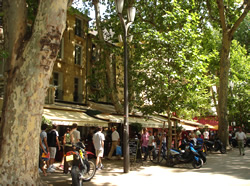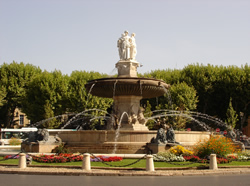 The climate of Aix has attracted people from all over France for many decades. The dry climate makes the hot summers (90s) bearable and the cold winters (40s) invigorating. Spring and fall are particularly delightful, with the early spring bringing an intoxicating sea of brilliant red poppies and the warm, breezy fall prolonged into November. The climate of Aix has attracted people from all over France for many decades. The dry climate makes the hot summers (90s) bearable and the cold winters (40s) invigorating. Spring and fall are particularly delightful, with the early spring bringing an intoxicating sea of brilliant red poppies and the warm, breezy fall prolonged into November.
The abundance of water in Aix in the form of springs has always been an important factor in the development of the city. From the Roman baths (recently rediscovered and modernized) through the flourishing courts of the Provençal counts and kings, water played a prestigious role in maintaining Aix a center of both health and pleasures. Today one counts 42 fountains in Aix, some dribbling with water, some gushing, all attractive landmarks of the city. The renovated “Thèrmes” hosts a state-of-the-art day spa where you can choose from among many different treatments for a relaxing and rejuvenating day. center of both health and pleasures. Today one counts 42 fountains in Aix, some dribbling with water, some gushing, all attractive landmarks of the city. The renovated “Thèrmes” hosts a state-of-the-art day spa where you can choose from among many different treatments for a relaxing and rejuvenating day.
The many churches and cathedrals of Aix bring a host of visitors each year. The St-Sauveur cathedral is a curious mix of Romanesque, Gothic, and Baroque styles since the construction spanned an incredible period of twelve centuries, from the fifth to the seventeenth. The private cloisters are among the best preserved and most beautiful found in France. Other churches are the Eglise St-Jean-de-Malte which houses the tombs of the Counts of Provence; the Eglise de la Madeleine which preserves a 15th century altarpiece of the Annunciation; and the Eglise St-Esprit of which the chapel of the Pénitents Gris is quite famous.
Aix boasts lively markets seven days a week. Whether it’s fresh flowers, roasted chicken, herbes de Provence, hand-made quilts and pottery, knives, books, jewelry, French soaps, fresh honey, you’ll find it all at the markets. Three times a week is the grand marché which now extends down the Cours Mirabeau as well as the Place Verdun; seven mornings a week, rain or shine, you can always find your fresh vegetables, fish, meats and cheese sold by local vendors on the Place Richelme.
The Hotel de Ville, the Palais Vendôme, the atelier Cézanne, the Musée Granet are all monuments and museums in Aix worth visiting. Paul Cézanne and the prolific write Emile Zola were classmates at the nearby Collège Mignet and both have left their mark on the city. Cézanne’s legacy is one of several paintings of the Montaigne Saint-Victoire, for which the Musée Granet was renovated and reopened in 2006. You can view the mountain yourself from several vantage points outside the city and you can even hike it in the off-season (October -May).
Other interesting visits one can make in Aix are to its famous candy factories: the “calissons d’Aix” are sold in various confiseries which still make them by the old-fashioned recipe. If it’s chocolate you seek, the “chocolats Puricard” factory is located just outside town. The Santons Fouque are the typical clay-based figurines made in a small atelier on the rue Gambetta which are a collector’s delight.
If it’s French classes you’re seeking in Aix, there are many which specialize in cours de français pour étrangers: several are within walking distance of the apartment. The I.S. School is a particularly good one, a mere 5 minutes from the Cours Mirabeau, and the American Institute on the rue Gaston de Saporta also offers classes for students and adults. |